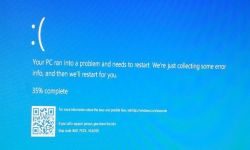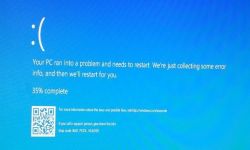FAQ
TL;DR: Windows 10 stuck on the spinning circle? Reset CMOS (remove the battery for 30 minutes) and boot a USB repair—"Prepare a flash drive with the system." Then run Startup Repair or scan the disk. [Elektroda, Anonymous, post #17919657]
Why it matters: This FAQ helps Windows 10 users recover from endless boot loops after hardware changes or infections, fast.
Quick Facts
- CMOS reset window: remove the motherboard battery for about 30 minutes to restore default BIOS settings. [Elektroda, Anonymous, post #17919657]
- To access recovery tools, boot the Windows installer and select Repair your computer instead of Install. [Elektroda, Anonymous, post #17919826]
- No Windows? Create a bootable MHDD medium to check the disk when you can’t test it elsewhere. [Elektroda, Anonymous, post #17919058]
- Isolate hardware: try one RAM module and, if needed, remove the GPU and use onboard video. [Elektroda, Anonymous, post #17919747]
- Real-case outcome: a full format and clean install fixed a heavily infected, overfilled drive causing the loop. [Elektroda, cooperator2000, post #17920244]
How do I fix a Windows 10 PC stuck on the spinning circle?
Work methodically. Boot with a single RAM module and test each stick and slot. If the system still hangs, remove the graphics card and connect the monitor to the motherboard video output. Then try booting from a Windows USB and choose Repair your computer. If it boots, continue with repairs; if not, proceed to a clean install after backups. This isolates RAM and GPU issues before software fixes and mirrors proven steps from the thread. [Elektroda, Anonymous, post #17919747]
Should I try Startup Repair or reinstall Windows?
Start with Startup Repair from a Windows 10 USB installer. On the setup screen, select Repair your computer, not Install. Run the automated repair first. If it can’t resolve the boot, move on to system file repairs, hardware isolation, and only then a clean reinstall. This order reduces data loss risk and aligns with the advised approach in the discussion. [Elektroda, Anonymous, post #17919826]
How do I reset the BIOS/CMOS on a Dell Inspiron 3847?
Shut down, unplug power, and press the power button for several seconds to discharge. Remove the small round CMOS battery from the motherboard. Wait about 30 minutes, reinstall the battery, then boot with one RAM stick. This reset clears potentially bad settings after GPU/PSU changes. It’s a safe first hardware step for spin-loop issues. [Elektroda, Anonymous, post #17919657]
Could my new graphics card or power supply cause the boot loop?
Yes. A marginal PSU or a faulty or incompatible GPU can prevent POST or Windows load. Remove the discrete GPU and connect your monitor to the motherboard’s video output to test with integrated graphics. Keep only one RAM module installed during testing. If the system starts, the add-in GPU or power delivery is suspect. [Elektroda, Anonymous, post #17919747]
How do I check if my hard drive is failing without Windows?
Create a bootable MHDD medium and run a surface scan to assess the drive. This works even when Windows won’t load. As one expert advised, “If you cannot check the disk on another computer, create a medium from MHDD.” If the drive passes, continue with Windows repairs. If it shows bad sectors, replace it. [Elektroda, Anonymous, post #17919058]
How do I run Startup Repair from a Windows USB installer?
- Boot from the Windows 10 USB installer and wait for the first setup screen.
- Select Repair your computer instead of Install.
- Open the recovery options and run Startup Repair, then follow prompts to restart.
This path launches Windows’ automated boot repair and requires no login to the broken system. [Elektroda, Anonymous, post #17919826]
How do I repair Windows system files (DISM/SFC) when it won’t boot?
Boot the Windows installer and open the repair environment Command Prompt. Run: DISM /Online /Cleanup-Image /RestoreHealth. When it completes, run: sfc /scannow. DISM repairs the component store used by SFC; SFC then restores protected system files. Reboot and test. If DISM cannot access the image, use an offline source with the /Source option. [Repair a Windows image]
My PC keeps loading for hours then restarts—what does that indicate?
A repeated long spin (e.g., 3 hours) followed by a restart indicates Windows cannot complete boot. It often points to corrupted system files, disk errors, or unstable firmware settings. In the thread, the system displayed a message that it could not start and then restarted after about 1.5 hours. Move to disk checks and repair steps. [Elektroda, cooperator2000, post #17918923]
I can’t share photos—how can I still show disk health?
Install CrystalDiskInfo on a working Windows machine, connect the suspect drive, and read the SMART status and key attributes. Note the Health Status (Good, Caution, Bad) and any reallocated or pending sectors. Share those values as text if screenshots are not possible. This gives a quick signal before deeper scans. [Elektroda, Anonymous, post #17919657]
What if Startup Repair fails or gets stuck?
Treat that as a failure case and continue hardware isolation. Boot with one RAM stick and test each slot. Remove the discrete GPU and use onboard graphics. If the system still won’t load, use a USB installer for DISM/SFC or proceed to a clean reinstall after backups. “If it doesn’t work” move to the next step. [Elektroda, Anonymous, post #17919747]
Is formatting necessary, and what do I lose?
Only after disk health checks, firmware reset, Startup Repair, and system file repairs fail. A clean install erases apps and system settings and usually wipes the system partition’s data unless you back up. In this case, a full format fixed the boot loop because the drive was heavily infected and overfilled. Back up first. [Elektroda, cooperator2000, post #17920244]
What’s a safe order to troubleshoot this boot loop?
Start with hardware basics: boot with one RAM module and try each slot. Then remove the graphics card and use onboard video. Next, boot a Windows USB installer and choose Repair your computer to attempt recovery. If that fails, continue with advanced repairs or a clean install. This sequence limits variables efficiently. [Elektroda, Anonymous, post #17919747]




